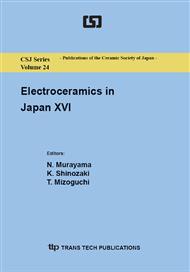p.145
p.149
p.153
p.157
p.161
p.165
p.169
p.174
p.181
Temperature Dependence of Resistivity of MoSi2-Si Composite Thin Films
Abstract:
The temperature dependence of resistivity for thin films of a composite of molybdenum disilicide (MoSi2) and silicon (Si) fabricated by radio frequency magnetron sputtering using a target made of a powder mixture of MoSi2 and Si with molar ratio of Si to Mo of 1:X (2.02X2.55) was analyzed. The temperature dependence could be explained by the multiplicative model consisting of a conduction model similar to the Grüneisen-Bloch model, a modified Anderson localization model for 2.02X2.21 and the modified Anderson localization model for 2.39X2.55 over a wide temperature range.
Info:
Periodical:
Pages:
161-164
Citation:
Online since:
September 2013
Authors:
Price:
Сopyright:
© 2014 Trans Tech Publications Ltd. All Rights Reserved
Share:
Citation:


